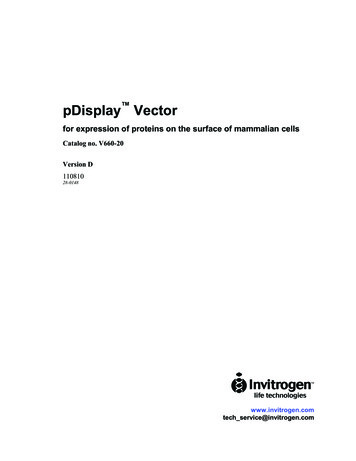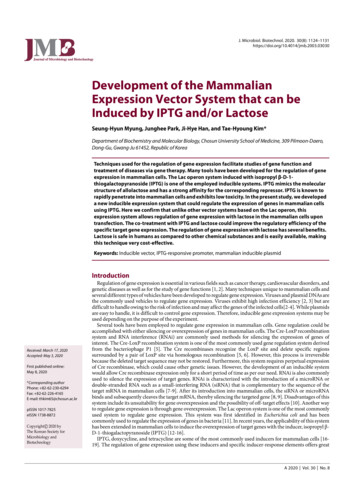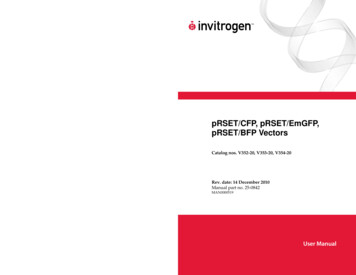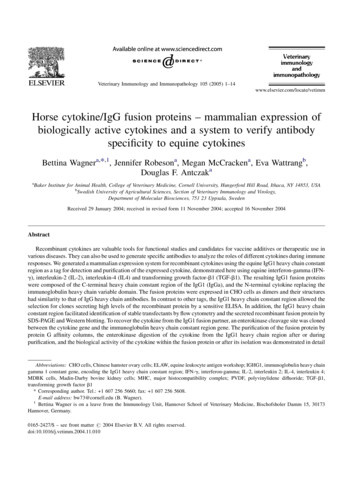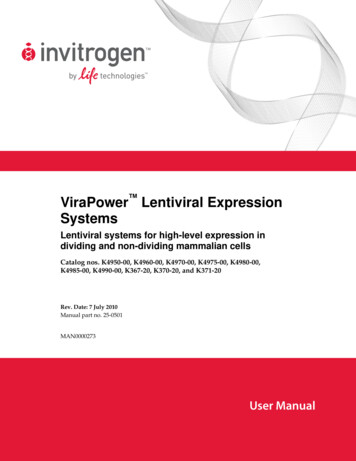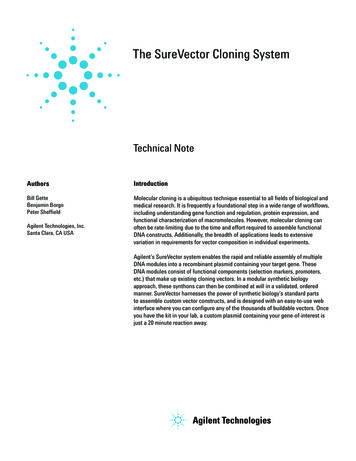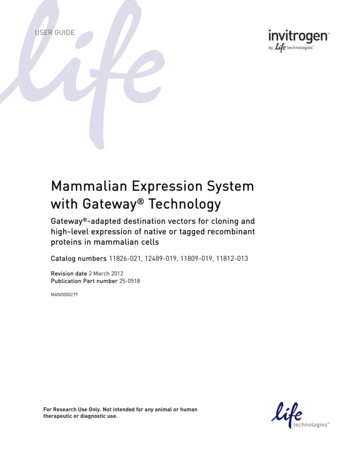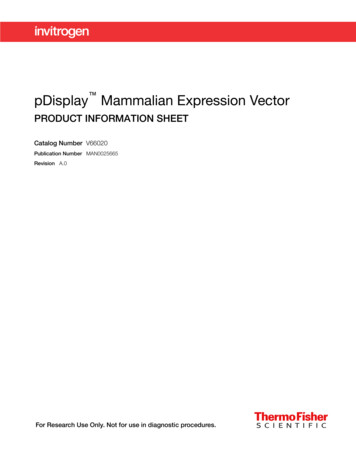
Transcription
pDisplay Mammalian Expression VectorPRODUCT INFORMATION SHEETCatalog Number V66020Publication Number MAN0025665Revision A.0For Research Use Only. Not for use in diagnostic procedures.
Life Technologies Corporation 5781 Van Allen Way Carlsbad, California 92008 USAFor descriptions of symbols on product labels or product documents, go to thermofisher.com/symbols-definition.The information in this guide is subject to change without notice.DISCLAIMER: TO THE EXTENT ALLOWED BY LAW, THERMO FISHER SCIENTIFIC INC. AND/OR ITS AFFILIATE(S) WILL NOT BELIABLE FOR SPECIAL, INCIDENTAL, INDIRECT, PUNITIVE, MULTIPLE, OR CONSEQUENTIAL DAMAGES IN CONNECTION WITH ORARISING FROM THIS DOCUMENT, INCLUDING YOUR USE OF IT.Revision history: Pub. No. MAN0025665RevisionDateA.027 September 2021Description Updated product form from lyophilized to liquid solution in TEBuffer. Renamed "Maintenance of pDisplay " to "Competent E. Coli". Initial release with new publication number format. Supersedes publication number 110810 28-0148 Rev. D. Updated to the current document template, with associatedupdates to trademarks, logos, licensing, and warranty.Important Licensing Information: These products may be covered by one or more Limited Use Label Licenses. By use of theseproducts, you accept the terms and conditions of all applicable Limited Use Label Licenses.TRADEMARKS: All trademarks are the property of Thermo Fisher Scientific and its subsidiaries unless otherwise specified. 2021 Thermo Fisher Scientific Inc. All rights reserved.
Contents CHAPTER 1 Product information . . . . . . . . . . . . . . . . . . . . . . . . . . . . . . . . . . . . . . . . . . . . . . . . . . 4Product description . . . . . . . . . . . . . . . . . . . . . . . . . . . . . . . . . . . . . . . . . . . . . . . . . . . . . . . . . . . . . 4Contents and storage . . . . . . . . . . . . . . . . . . . . . . . . . . . . . . . . . . . . . . . . . . . . . . . . . . . . . . . . . . . . 4Recommended materials not supplied . . . . . . . . . . . . . . . . . . . . . . . . . . . . . . . . . . . . . . . . . . . . . 5Product qualification . . . . . . . . . . . . . . . . . . . . . . . . . . . . . . . . . . . . . . . . . . . . . . . . . . . . . . . . . . . . . 6 CHAPTER 2 Guidelines and recommendations . . . . . . . . . . . . . . . . . . . . . . . . . . . . . . . . . . 7Guidelines for cloning . . . . . . . . . . . . . . . . . . . . . . . . . . . . . . . . . . . . . . . . . . . . . . . . . . . . . . . . . . . . 7Guidelines for transformation and transfection . . . . . . . . . . . . . . . . . . . . . . . . . . . . . . . . . . . . . . 9Before you begin . . . . . . . . . . . . . . . . . . . . . . . . . . . . . . . . . . . . . . . . . . . . . . . . . . . . . . . . . . . 9Recommended methods . . . . . . . . . . . . . . . . . . . . . . . . . . . . . . . . . . . . . . . . . . . . . . . . . . . . . 9 Guidelines for Geneticin selection . . . . . . . . . . . . . . . . . . . . . . . . . . . . . . . . . . . . . . . . . . . 9Recommended methods to detect displayed proteins . . . . . . . . . . . . . . . . . . . . . . . . . . 10Troubleshooting . . . . . . . . . . . . . . . . . . . . . . . . . . . . . . . . . . . . . . . . . . . . . . . . . . . . . . . . . . . . . . . . 10 APPENDIX A Supplemental information . . . . . . . . . . . . . . . . . . . . . . . . . . . . . . . . . . . . . . . . . 11 Features of the pDisplay Mammalian Expression Vector . . . . . . . . . . . . . . . . . . . . . . . . . . . 11 Map of pDisplay Mammalian Expression Vector . . . . . . . . . . . . . . . . . . . . . . . . . . . . . . . . . . 13 APPENDIX B Safety . . . . . . . . . . . . . . . . . . . . . . . . . . . . . . . . . . . . . . . . . . . . . . . . . . . . . . . . . . . . . . . 14Chemical safety . . . . . . . . . . . . . . . . . . . . . . . . . . . . . . . . . . . . . . . . . . . . . . . . . . . . . . . . . . . . . . . . 14Biological hazard safety . . . . . . . . . . . . . . . . . . . . . . . . . . . . . . . . . . . . . . . . . . . . . . . . . . . . . . . . . 15 APPENDIX C Documentation and support . . . . . . . . . . . . . . . . . . . . . . . . . . . . . . . . . . . . . . 16Customer and technical support . . . . . . . . . . . . . . . . . . . . . . . . . . . . . . . . . . . . . . . . . . . . . . . . . 16Limited product warranty . . . . . . . . . . . . . . . . . . . . . . . . . . . . . . . . . . . . . . . . . . . . . . . . . . . . . . . . 16pDisplay Mammalian Expression Vector Product Information Sheet3
1Product informationIMPORTANT! Before using this product, read and understand the information in the “Safety” appendixin this document.Product descriptionThe Invitrogen pDisplay Mammalian Expression Vector is a 5.3 kb mammalian expression vectorthat allows display of proteins on the cell surface. Proteins expressed from the pDisplay vector arefused at the N-terminus to the murine Ig κ-chain leader sequence and at the C-terminus to the plateletderived growth factor receptor (PDGFR) transmembrane domain. The N-terminus to the murine Igκ-chain leader sequence directs the protein to the secretory pathway. The C-terminus to the PDGFRtransmembrane domain anchors the protein to the plasma membrane, displaying it on the extracellularside. Recombinant proteins expressed from the pDisplay vector contain the hemagglutinin A and mycepitopes for detection by western blot or immunofluorescence. To get started with cloning into thepDisplay vector, see “Guidelines for cloning” on page 7.The pDisplay Mammalian Expression Vector has been used to express c-Jun and a single chainantibody against phOx hapten. Both proteins were shown to be correctly expressed at the cellsurface by incubation with anti-Myc antibody followed by incubation with a magnetic bead-conjugatedsecondary antibody. Transfected cells were selected by using a magnet.Contents and storageCatalog numbers that appear as links open the web pages for those products.Plasmids are shipped at room temperature. Upon receipt, store the plasmid as indicated.ContentspDisplay MammalianExpression Vector4Cat. No.AmountStorageV6602020 μg in TE Buffer, pH 8.0-20 pDisplay Mammalian Expression Vector Product Information Sheet
Chapter 1 Product informationRecommended materials not supplied1Recommended materials not suppliedUnless otherwise indicated, all materials are available through thermofisher.com. "MLS" indicates thatthe material is available from fisherscientific.com or another major laboratory supplier.Catalog numbers that appear as links open the web pages for those products.ProductQuantityCat. No.Myc Tag Monoclonal Antibodies, one of the following (or equivalent):Myc Tag Monoclonal Antibody50 μLR950-25Myc Tag Monoclonal Antibody,HRP50 μLR951-25Myc Tag Monoclonal Antibody, AP50 μLR952-25One Shot BL21 Star (DE3)Chemically Competent E. coli21 x 50 μLC601003BL21 Star (DE3)pLysSOne Shot Chemically CompetentE. coli21 x 50 μLC602003BL21-AI One Shot ChemicallyCompetent E. coli21 x 50 μLC607003One Shot TOP10F' ChemicallyCompetent E. coli21 x 50 μLC303003Geneticin Selective Antibiotic(G418 Sulfate), Powder1g11811023Geneticin Selective Antibiotic(G418 Sulfate), Powder5g11811031Competent E. coli[1]Geneticin antibiotics[1]Chemically-competent and electrocompetent TOP10F' cells are available from www.thermofisher.com.pDisplay Mammalian Expression Vector Product Information Sheet5
1Chapter 1 Product informationProduct qualificationProduct qualificationThe pDisplay Mammalian Expression Vector (Cat. No. V66020) is qualified by restriction digest.Restriction digests must demonstrate the correct banding pattern when electrophoresed on an agarosegel. The following table lists the restriction enzymes used to digest the vector and the expectedfragments.Restriction enzymeBamH I6Expected fragments170 bp5,155 bpBgl II5,325 bpPst I5,325 bppDisplay Mammalian Expression Vector Product Information Sheet
2Guidelines and recommendationsGuidelines for cloningThis section provides general guidelines for cloning your gene of interest into the pDisplay MammalianExpression Vector.The pDisplay Mammalian Expression Vector is a fusion vector requiring that you clone your gene ofinterest in frame with the initiation ATG of the N-terminal Ig κ-chain leader sequence and the C-terminalmyc epitope/PDGFR-TM. It may be necessary to use PCR to create a fragment with the appropriaterestriction sites to clone in frame at both ends. Carefully inspect your gene and the multiple cloning sitebefore cloning your gene of interest (see Figure 1).pDisplay Mammalian Expression Vector Product Information Sheet7
2Chapter 2 Guidelines and recommendationsGuidelines for cloningFigure 1 Multiple cloning site of the pDisplay Mammalian Expression VectorRestriction sites are labeled to indicate the cleavage site. The multiple cloning site has been confirmed by sequencing andfunctional testing.8pDisplay Mammalian Expression Vector Product Information Sheet
Chapter 2 Guidelines and recommendationsGuidelines for transformation and transfection2Guidelines for transformation and transfectionThis section provides general guidelines and recommendations for transformation and transfection.Before you beginE. coli transformation Transform your ligation mixtures into a competent recA, endA E. coli strain(e.g., TOP10, TOP10F , DH5α), then select on LB plates containing 50–100 μg/mL ampicillin. Select10–20 clones, then analyze for the presence and orientation of your insert. We recommend that you sequence your construct with the T7 Promoter Primer (Cat. No. N56002)and a gene specific reverse primer to confirm that your gene is correctly fused to the Ig κ-chainleader sequence at the N-terminus and the myc/PDGFR-TM peptide at the C-terminus.Plasmid preparationOnce you have confirmed that your gene is correctly fused, prepare plasmid DNA for transfection.Plasmid DNA for transfection into eukaryotic cells must be clean and free from phenol and sodiumchloride. Contaminants will kill the cells and salt will interfere with lipids, decreasing transfectionefficiency. We recommend using the S.N.A.P. Plasmid DNA MiniPrep Kit (Cat. No. K190001) forisolation of 10–15 μg of plasmid DNA or CsCl gradient centrifugation for isolation of 15 μg of plasmidDNA.Recommended methodsFor established cell lines (e.g., HeLa, 293), consult the supplier of your cell line for the optimal methodof transfection. It is recommended that you follow exactly the protocol for your cell line. Pay particularattention to medium requirements, when to pass the cells, and at what dilution to split the cells.Guidelines for Geneticin selectionGeneticin antibiotic blocks protein synthesis in mammalian cells by interfering with ribosomal function.It is an aminoglycoside, similar in structure to neomycin, gentamycin, and kanamycin. Expression of thebacterial aminoglycoside phosphotransferase gene (APH), derived from Tn5, in mammalian cells resultsin detoxification of Geneticin antibiotic. Prepare Geneticin antibiotic in a buffered solution (e.g. 100 mM HEPES, pH 7.3). Calculate the concentration based on the amount of active drug (check the lot label). Use 100 – 800 μg/ml of Geneticin antibiotic in complete medium. Test varying concentrations of Geneticin antibiotic on your cell line to determine the concentrationthat kills your cells (kill curve). Cells differ in their susceptibility to Geneticin antibiotic.Cells will divide once or twice in the presence of lethal doses of Geneticin antibiotic, so the effects ofthe drug take several days to become apparent. Complete selection can take up to 3 weeks of growthin selective medium.pDisplay Mammalian Expression Vector Product Information Sheet9
2Chapter 2 Guidelines and recommendationsTroubleshootingRecommended methods to detect displayed proteinsTo confirm that your protein is displayed on the cell membrane, we recommend the following methods: In situ immunofluorescent labeling of cells with antibodies to c-Myc In situ immunofluorescent labeling of cells with antibodies to hemagglutinin A An indirect magnetic selection procedure with a magnetic bead-conjugated secondary antibodyTroubleshootingObservationProtein is not displayedPossible causeProtein is not in frame withPDGFR-TM.Recommended actionUse antibody to hemagglutinin or myc tocheck for expression.Sequence your construct to check frame.No expression10Method of transfection is notoptimal.Optimize transfection or change transfectionmethod.Protein is not in frame with Igk-chain leader sequence.Sequence your construct to check frame.pDisplay Mammalian Expression Vector Product Information Sheet
ASupplemental informationFeatures of the pDisplay Mammalian Expression VectorpDisplay Mammalian Expression Vector (5,325 bp) contains the following elements. All features havebeen functionally tested.FeatureBenefitHuman cytomegalovirus (CMV) immediate-earlypromoter/enhancerPermits efficient, high-level expression of yourrecombinant protein.T7 promoter/priming siteAllows for in vitro transcription in the senseorientation and sequencing through the insert.ATG initiation codonPermits initiation of translation of the pDisplay vector fusion protein.Murine Ig κ-chain leader sequenceTargets protein to secretory pathway.Hemagglutinin A epitope tag (Tyr-Pro-Tyr-Asp-ValPro-Asp-Tyr-Ala)Allows detection of the fusion protein by monoclonalantibody 12CA5.Multiple cloning region with eight unique sitesAllows insertion of your gene and facilitates cloning.Myc epitope (Glu-Gln-Lys-Leu-Ile-Ser-Glu-Glu-AspLeu)Allows detection of the pDisplay vector fusionprotein with the anti-Myc antibodies.Platelet-derived growth factor receptortransmembrane domain (PDGFR-TM)Anchors the fusion protein to the plasma membranefor display.Bovine growth hormone (BGH) polyadenylationsignalEfficient transcription termination andpolyadenylation of mRNA.pUC originHigh-copy number replication and growth in E. coli.SV40 early promoter and originPermits expression of the kanamycin resistance genefor Geneticin antibiotic resistance in mammaliancells.Allows episomal replication in cells containing SV40large T antigen.Kanamycin resistance geneConfers resistance to Geneticin antibiotic inmammalian cells.TK polyadenylation signalEfficient transcription termination andpolyadenylation of kanamycin resistance genemRNA.pDisplay Mammalian Expression Vector Product Information Sheet11
AAppendix A Supplemental informationFeatures of the pDisplay Mammalian Expression Vector(continued)Feature12BenefitAmpicillin resistance gene (β-lactamase)Selection in E. coli.f1 originAllows rescue of single-stranded DNA.pDisplay Mammalian Expression Vector Product Information Sheet
Appendix A Supplemental informationMap of pDisplay Mammalian Expression VectorAMap of pDisplay Mammalian Expression VectorThe following map summarizes the features of the pDisplay Mammalian Expression Vector. For thecomplete sequence of the vector, go to www.thermofisher.com or contact Technical Support (see“Customer and technical support” on page 16). Details of the multiple cloning site are shown onpage 11 Figure 2 Map of pDisplay Mammalian Expression Vector Vector Comments for the pDisplay Mammalian Expression Vector: 5325 necleotides1 CMV promoter: bases 1-5962 T7 promoter: bases 638-6573 Murine Ig kappa-chain V-J2-C signal peptide: bases737-7994 Hemagglutinin A epitope: bases 800-8265 Multiple Cloning Site: bases 827-8736 myc epitope: bases 874-9037 PDGFR transmembrane domain: bases 907-1056pDisplay Mammalian Expression Vector Product Information Sheet8 Bovine growth hormone polyadenylation signal: bases1069-12889 pUC origin: bases 1378-205110 Thymidine kinase polyadenylation site: bases2458-218711 Neomycin/Kanamycin resistance gene: bases3421-236612 SV40 origin and promoter: bases 3797-345613
BSafetyWARNING! GENERAL SAFETY. Using this product in a manner not specified in the userdocumentation may result in personal injury or damage to the instrument or device. Ensure thatanyone using this product has received instructions in general safety practices for laboratories andthe safety information provided in this document.· Before using an instrument or device, read and understand the safety information provided in the·user documentation provided by the manufacturer of the instrument or device.Before handling chemicals, read and understand all applicable Safety Data Sheets (SDSs) and useappropriate personal protective equipment (gloves, gowns, eye protection, and so on). To obtainSDSs, see the “Documentation and Support” section in this document.Chemical safetyWARNING! GENERAL CHEMICAL HANDLING. To minimize hazards, ensure laboratory personnelread and practice the general safety guidelines for chemical usage, storage, and waste providedbelow. Consult the relevant SDS for specific precautions and instructions:· Read and understand the Safety Data Sheets (SDSs) provided by the chemical manufacturer···before you store, handle, or work with any chemicals or hazardous materials. To obtain SDSs, seethe "Documentation and Support" section in this document.Minimize contact with chemicals. Wear appropriate personal protective equipment when handlingchemicals (for example, safety glasses, gloves, or protective clothing).Minimize the inhalation of chemicals. Do not leave chemical containers open. Use only withsufficient ventilation (for example, fume hood).Check regularly for chemical leaks or spills. If a leak or spill occurs, follow the manufacturercleanup procedures as recommended in the SDS.Handle chemical wastes in a fume hood.·· Ensure use of primary and secondary waste containers. (A primary waste container holds theimmediate waste. A secondary container contains spills or leaks from the primary container.Both containers must be compatible with the waste material and meet federal, state, and localrequirements for container storage.)After emptying a waste container, seal it with the cap provided.·· Characterize (by analysis if needed) the waste generated by the particular applications, reagents,··14and substrates used in your laboratory.Ensure that the waste is stored, transferred, transported, and disposed of according to all local,state/provincial, and/or national regulations.IMPORTANT! Radioactive or biohazardous materials may require special handling, and disposallimitations may apply.pDisplay Mammalian Expression Vector Product Information Sheet
Appendix B SafetyBiological hazard safetyBBiological hazard safetyWARNING! BIOHAZARD. Biological samples such as tissues, body fluids, infectious agents,and blood of humans and other animals have the potential to transmit infectious diseases.Conduct all work in properly equipped facilities with the appropriate safety equipment (for example,physical containment devices). Safety equipment can also include items for personal protection,such as gloves, coats, gowns, shoe covers, boots, respirators, face shields, safety glasses, orgoggles. Individuals should be trained according to applicable regulatory and company/ institutionrequirements before working with potentially biohazardous materials. Follow all applicable local,state/provincial, and/or national regulations. The following references provide general guidelines whenhandling biological samples in laboratory environment.· U.S. Department of Health and Human Services, Biosafety in Microbiological and Biomedical·Laboratories (BMBL), 6th Edition, HHS Publication No. (CDC) 300859, Revised June ory biosafety manual, fourth edition. Geneva: World Health Organization; 2020 (Laboratorybiosafety manual, fourth edition and associated 011311pDisplay Mammalian Expression Vector Product Information Sheet15
CDocumentation and supportCustomer and technical supportVisit thermofisher.com/support for the latest service and support information. Worldwide contact telephone numbers Product support information– Product FAQs– Software, patches, and updates– Training for many applications and instruments Order and web support Product documentation– User guides, manuals, and protocols– Certificates of Analysis– Safety Data Sheets (SDSs; also known as MSDSs)Note: For SDSs for reagents and chemicals from other manufacturers, contact themanufacturer.Limited product warrantyLife Technologies Corporation and/or its affiliate(s) warrant their products as set forth in theLife Technologies' General Terms and Conditions of Sale at onditions.html. If you have any questions, please contact Life Technologies atwww.thermofisher.com/support.16pDisplay Mammalian Expression Vector Product Information Sheet
pDisplay Mammalian Expression Vector UG F8AB-2021/07/26 21:11:52 en22:51:25.309 01:00thermofisher.com/support thermofisher.com/askaquestionthermofisher.com27 September 2021
pDisplay Mammalian Expression Vector is a 5.3 kb mammalian expression vector that allows display of proteins on the cell surface. Proteins expressed from the pDisplay
